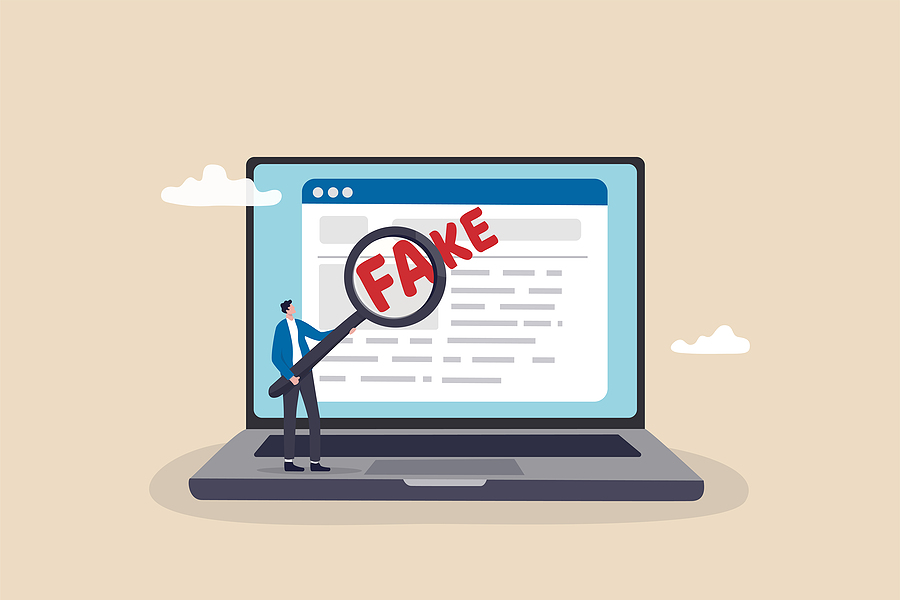It’s important that you spot the signs of a fake website as soon as possible, especially if you’re looking to make a purchase through it. However, even if you aren’t wanting to carry out a transaction there, it would still be easy enough for the owners of that site to collect your information without your consent, resulting in identity theft or financial fraud.
The best thing you can do in order to protect yourself, your family and your employees, if you run your own business, is to make sure that everyone knows the signs to look for if they suspect a website is fake. Here’s how to spot a bogus site:
Look closely at the domain name
One of the easiest and most common ways of checking whether or not a website is fake is to look at the domain name. There are some other details about the domain that you should check as well, but we’ll get onto that later in this article. But that doesn’t mean to say that you can’t pick out crucial information from the name alone.
If the domain name doesn’t match the official website name or company, then it’s likely fake. Scammers will often use names that are similar to an official URL, or they might include some of the legitimate domain name within the bogus one to give it more authenticity. Don’t let that fool you.
For example, VANS could become victim to scammers in the sense that they’ll create a fake site that reads www.vanns.com instead of www.vans.co.uk. Although only a subtle difference, it’s not always something that internet users look closely enough at in order for them to notice.
Always look at the domain name for dodgy spellings, hyphens, punctuation and other aspects that don’t appear genuine. You should always check the domain name, making sure that you’re on the legitimate site, especially before entering any personal information, including data such as:
- Your name
- Your address
- Telephone numbers
- Bank details
- Billing information
- Date of birth
Check for a padlock symbol
This is a common piece of advice that is given to internet users throughout the globe, and it’s often a great way to verify whether or not a website is fake. If it doesn’t contain a padlock in the browser, then it’s more likely that the website is fake, but it could also simply mean that it’s not a secure site for you to be entering your personal details into.
Look at it as something to be cautious about and think twice before giving your data away. The padlock symbol should be viewed as a sign that a website is safe to use, but don’t use it as the sole means of verification. You must use this tip in conjunction with other steps on this list to make doubly sure that a website is official and secure for you to input details into, if needed.
Use a website checker & only use safe browsing tools
Website checkers are a great way of helping you to verify a secure or bogus website. A website checker will be able to tell you things like: if the site uses encryption to protect your data and the site’s level of verification certificate.
Website checkers are a great place to start if you aren’t sure about whether a site is a spoof or not, but it’s also important for you to know that scammers are finding ways to get around those checkers in order to evade detection. In addition to this, you will also need to follow the other steps outlined here, just to be sure.
Keep an eye out for poor spelling, grammar & design issues
Scammers who have developed bogus websites will often not take the time out to make sure that the copy is immaculately-worded and that the grammar is spot on. Even if they ran it through a spell-checker, it’s unlikely to detect every single mistake that’s made, especially if it’s in American English. This is something else you’ll need to look out for. If you’re looking at, what should be, a British website and it contains American spellings and words, then it’s likely not a legitimate website.
The same goes for poor spelling and grammar in general. A real website owner would have taken the time and invested money in the writing of the copy and the design of their site in order for it to look as good and as safe as possible. If the website isn’t up to scratch, then it’s likely to have been designed and developed by scammers. You should also look out for red flags in the design of the site in addition to the text.
Find the age of the domain & how long the site has been active for
Another great way of finding out if a website is fake or not is by checking the age of the domain and/or how long the site has been active for. If it’s a relatively new site, then you should be suspicious, especially if it’s coupled with a few other warning signs on our list.
There are plenty of ways in which you’ll be able to check the age of a domain, notably the Wayback Machine will be able to help you to determine its age. Simply type the URL into the search bar and it will provide you with all of the information you’ll need to know about the age of the website.
If details are too good to be true, they probably are
If the website claims that if you sign up to their newsletter, providing them with your name, date of birth, email address and a telephone number, you’ll be in with a chance of winning £1 million, then it’s probably too good to be true, especially if it’s a company you’ve never heard of or if their site is only a few months old. If something sounds too good to be true, it probably is, and there’s likely a reason why they’re trying to entice you in – for your personal details.
Research user reviews
Before purchasing goods or committing to a service that’s supplied by that company, make sure you first look at customer reviews. There are plenty of places online where those reviews will be publicly available, such as Trustpilot, Google, Facebook and more. These are often raw reviews put on by real customers and so you’ll know once and for all whether or not a site is legitimate.
It can also help you to determine whether they’re charging people good money for inferior quality goods or counterfeit products. It might be that they’re providing you with a product, but it’s not what you thought it would be. Look at customer reviews online before deciding to make purchases through a site that looks to be bogus.
Run a virus scan for peace of mind
For absolute peace of mind, people often choose to run virus software after clicking on a site that they think is illegitimate. Even so, it would be a good idea to run one after you’ve finished browsing the net, because you can never be sure. This is a great way of ensuring your computer stays virus-free, even if you have clicked on something that appears to be dodgy. Cover your back and give yourself peace of mind by running anti-virus software after each surf of the web.
ICU IT is a dedicated IT specialist firm, dedicated to providing companies and businesses alike with sterling IT services, including hosting cloud services, IT consultancy, IT maintenance services and more. For further information about how we can help you today, get in touch with a member of our friendly, professional team – we’re always pleased to hear from you.

